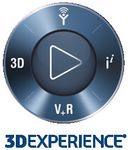WHAT'S NEW IN BIOVIA MATERIALS STUDIO 2019
←
→
Page content transcription
If your browser does not render page correctly, please read the page content below
WHAT’S NEW IN BIOVIA MATERIALS STUDIO 2019 Datasheet BIOVIA Materials Studio 2019 is the latest release of BIOVIA’s predictive science tools for chemistry and materials science research. Materials Studio empowers researchers to understand the relationships between a material’s ato- mic and molecular structure and properties in order to make more informed decisions about material research and development. Using Materials Studio 2019 scientists can simulate more materials and more properties than ever before - for example in the design of new catalysts or new battery materials.
MORE SCIENCE – REACTION KINETICS
A new module, Kinetix, has been made available. Kinetix
provides predictions for the spacial distribution of reactants and
products on reactive surfaces, such as catalyst surfaces, as a
function of time using a Kinetic Monte Carlo approach.
Tasks for examining the sensitivity of reaction mechanisms to
individual reactions and for studying temperature programmed
desorption have also been added to Materials Studio Cantera,
to add yet more to the extensive suite of chemical engineering
tools available in Materials Studio.
DENSITY FUNCTIONAL THEORY FOR 1000S
OF ATOMS
The features of ONETEP available through Materials Studio
ONETEP UI has been significantly enhanced by adding
Figure 1. Image representing occupancy of
capabilities for electron and spin transport, time dependent
Kinetix grid by adsorbate species during
DFT for electronic excitation energies, optimization of the total
Kinetic Monte Carlo simulations
spin of metallic systems and extension of solvation models to
geometry optimization, transition state search and dynamics
tasks. MATERIALS STUDIO 2019 HIGHLIGHTS
MORE MATERIAL PARAMETERS Reaction Kinetics Extensions
A new DFTB+ library, LIB 2019, designed for simulations of New feature! Sensitivity analysis has been added to Cantera
electrolytes in Li-ion batteries, has been added. The library CSTR task. This feature allows user to determine the most
contains parameters for the elements Li, C, H, O, N, F, P and important steps in the reaction chain and potentially save time
will allow Li-ion diffusion to be measured as a function of on simulations of complex multi-step reaction mechanisms
electrolyte formulation. New GULP libraries for MEAM and by excluding less important reactions from needing to be
ReaxFF RDX are also made available which can be applied to considered. It is equally important to know which reactions
battery and high energy materials respectively. merit more accurate calculations of thermodynamics and
reaction barriers.
PERFORMANCE IMPROVEMENTS New feature! A new task for simulation of Temperature
Hybrid OpenMP/MPI parallelization has been made available Programmed Desorption has been introduced in the Cantera
for ONETEP and CASTEP calculations that will improve module.
performance on compute clusters. Defaults have also been
New script! A script has been developed to import third-party
adjusted in ONETEP and Mesocite to improve performance
reaction mechanisms into Materials Studio to be used with
without sacrificing accuracy. DMol3 geometry optimization in
Cantera.
delocalized internal coordinates can also lead to substantial
performance increases on highly parallel computers and/or for Quantum Mechanics Highlights
large systems, now that checkpoint information is no longer
Enhanced performance! Finite displacement calculations of
written to disk.
vibrational properties with CASTEP can be now performed using
Low-memory BFGS method with preconditioning (LBFGS) has the “interpolation” option. This scheme uses non-diagonal
been implemented in CASTEP geometry optimizer. LBFGS supercells as developed by Lloyd-Williams and Monserrat and is
calculations can reduce the number of optimization steps more efficient than the previously available approach.
significantly, especially for systems with large number of
New feature! CASTEP calculations of chemical shifts are now
degrees of freedom.
possible for highly correlated systems where the use of DFT+U
approach is required (for example, transition metal oxides or
MORE PROPERTIES
systems containing f-elements).
Mulliken population analysis can now be applied in CASTEP for
calculations with spin-orbit coupling. Additionally, prediction of New feature! The many-body dispersion (MBD) correction
chemical shifts are now possible for highly correlated systems scheme by Ambrosetti et al. (2014) has been implemented
where the use of DFT+U approach is required (for example, in CASTEP and offers a more accurate description of weakly
transition metal oxides or systems containing f-elements). bonded systems than other existing approaches. The MBD
scheme supports full geometry optimization and property
calculations.New feature! CASTEP output now reports the result of the Classical Simulation Highlights
check for “ghost states” that might be associated with the given New feature! The forcefield document, and Forcite and
pseudopotentials. If such states are found, results of optical Mesocite, now support the tabulated form for torsion
properties calculations and band structure or DOS calculations interactions.
of the conduction band will have spurious features. A number
of settings for on the fly generation of pseudopotentials have New feature! Forcite geometry optimization has been extended
been modified to eliminate ghost states. to allow for the optimization of a charged system which is
subject to an electric field.
New script! A script for merging DFTB+ parameter files has
been added to the DFTB+ Parameterization Tool Set available The latest version of GULP code, 5.1, has been incorporated in
in the BIOVIA Materials Studio Community. Materials Studio.:
New feature! The SCAN meta-GGA functional has been added • New modified embedded atom model parameters for MEAM-
to DMol3. 2NN library to extend the range of accessible systems
and MEAM-2NN-QEq, for modeling of Li-Mn-O materials
New feature! A checkbox has been added to the geometry relevant for simulations of batteries
optimization and TS optimization dialogs in DMol3 to enable
the use of Cartesian coordinates for optimization. • Split bond charge electronegativity equalization method
(EEM) added
More usable! DMol3 reporting of exchange-correlation
functionals in the outmol file has been simplified and made • Third party package Alamode, that allows calculation of
more user friendly and reporting of the progress of a DMol3 thermal conductivity via the Boltzmann transport equations,
Geometry Optimization or Transition State Optimization has can be connected GULP server. *
been improved to explain why the process might continue even • Grüneisen parameters, phonon group velocities, mean
though the force and energy criteria are satisfied. squared displacements for phonon thermal parameters,
New feature! Numerically stable Kohn-Sham eigenvalue solver eigenvalues of elastic constants for elastic stability check
has been added to enable solution of extremely rare systems • New potential forms added: Slater potential and buffered
where DMol3 detects a singular overlap matrix. 14-7 Lennard-Jones potential
More usable! QMERA calculations now allow you to set initial • Fitting of free energy and of absolute dipole moment
spins on atoms in the QM region for spin-polarized calculations.
• Vibrational frequencies for molecules and (at Gamma point)
New feature! The ability to set global NGWFs radii for all for solids have been made available for ReaxFF and MEAM
elements has been added to the ONETEP interface. families of libraries
* Note: No Materials Studio interface to Alamode or third party
software is provided.
New parameters! The ReaxFF RDX library by Liu et al. (2011)
has been added to GULP module to enable modeling of
energetic materials.
Reflex
In Reflex Powder Solve and Powder Refinement, torsional
degrees of freedom can now be restrained during refinement,
by specifying a maximum variation.
Visualization and Usability Highlights
• File compression is now used by default for AVI movie
export of trajectory animations from Materials Studio. This
results in a typical file size reduction by a factor of ten. It is
also observed that there are fewer playback problems with
compressed AVI video than there had been for uncompressed
AVI video.
• You can now browse a job folder of a running Pipeline
Pilot protocol through a web browser, this is analogous to
browsing gateway jobs.
Figure 2. Image showing atomistic model of • A new algorithm has been implemented for constructing
chemisorbed carbon monoxide on a Reaction Previews for 3D periodic systems.
RuO2(110) catalyst surface • Structures with field density data can now be exported asfinal outcome is presented.
• Temperature programmed desorption: Introduces the use
of Cantera for temperature programmed desorption.
• Employing cluster expansion to calculate random alloy
stability and properties using Pipeline Pilot: Demonstrates
how to run the Random Alloy Stability and Properties (Cluster
Expansion) protocol in the Materials Studio Collection for
Pipeline Pilot from Materials Studio.
• Calculating random alloy properties using Pipeline Pilot:
Demonstrates how to run the Random Alloy Properties
©2019 Dassault Systèmes. All rights reserved. 3DEXPERIENCE®, the Compass icon, the 3DS logo, CATIA, SOLIDWORKS, ENOVIA, DELMIA, SIMULIA, GEOVIA, EXALEAD, 3D VIA, BIOVIA, NETVIBES, IFWE and 3DEXCITE are commercial trademarks or registered trademarks of
Dassault Systèmes, a French “société européenne” (Versailles Commercial Register # B 322 306 440), or its subsidiaries in the United States and/or other countries. All other trademarks are owned by their respective owners. Use of any Dassault Systèmes or its subsidiaries
(Quasirandom Structures) protocol in the Materials Studio
Collection for Pipeline Pilot from Materials Studio.
Figure 3. Image showing dissociation of
ethylene carbonate during molecular • Cross-linking polymers using Pipeline Pilot: Demonstrates
dynamics simulation of a typical battery how to run the Create Polymer Network protocol in the
electrolyte formulation using LIB2019 Materials Studio Collection for Pipeline Pilot, from Materials
DFTB+ library. Studio.
• Calculating the stress-strain diagram using Pipeline Pilot:
Abaqus .inp models. The density fields are used to determine Demonstrates how to run the Calculate Yield Stress and
the material at each point, and elements in the Abaqus model Critical Distortional Strain protocol in the Materials Studio
are assigned to sets accordingly. Collection for Pipeline Pilot from Materials Studio.
• The Pipeline Pilot Connector will now allow you to access • Calculating the glass transition temperature using Pipeline
some parameters from a protocol’s Implementation tab. This Pilot: Demonstrates how to run the Calculate Glass Transition
means that you can now use the Pipeline Pilot Connector to Temperature protocol in the Materials Studio Collection for
submit an entire protocol to a queuing system. Pipeline Pilot, from Materials Studio.
Enhancements to MaterialsScript
• Vector operations in MaterialsScript are now fully supported
and documented.
• The ONETEP module is now scriptable with MaterialsScript.
New Tutorials
The following new tutorials have been added:
• Mechanism reduction using sensitivity analysis: Introduces
the use of Cantera sensitivity analysis for studying reaction
mechanisms. The problem-specific reduction of a reaction
mechanism to contain only the reactions essential for the
trademarks is subject to their express written approval.
Our 3DEXPERIENCE® platform powers our brand applications, serving 12 industries, and provides a
rich portfolio of industry solution experiences.
Dassault Systèmes, the 3DEXPERIENCE® Company, provides business and people with virtual universes to imagine sustainable innovations. Its
world-leading solutions transform the way products are designed, produced, and supported. Dassault Systèmes’ collaborative solutions foster social innovation,
expanding possibilities for the virtual world to improve the real world. The group brings value to over 210,000 customers of all sizes in all industries in more than
140 countries. For more information, visit www.3ds.com.
Americas Europe/Middle East/Africa Asia-Pacific
Dassault Systèmes Dassault Systèmes Dassault Systèmes K.K.
175 Wyman Street 10, rue Marcel Dassault ThinkPark Tower
Waltham, Massachusetts CS 40501 2-1-1 Osaki, Shinagawa-ku,
02451-1223 78946 Vélizy-Villacoublay Cedex Tokyo 141-6020
USA France Japan
DS-9876-1218You can also read























































